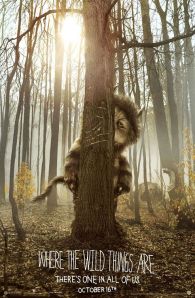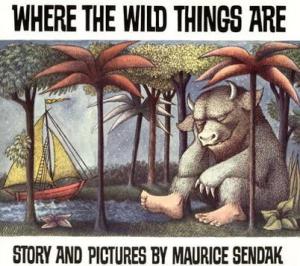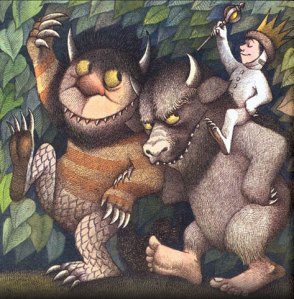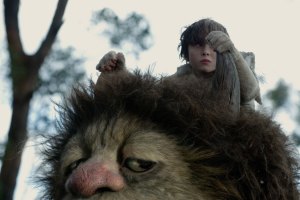Where the Wild Things Are
WHERE THE WILD THINGS ARE review

My husband does not like to go out to the movies. But after viewing the trailer for Where the Wild Things Are a few weeks ago he changed his mind. “That,” he told me, “I would see in the theater. We can bring the 3-year-old.” Here my heart sank: I was ecstatic that my husband was willing to venture out of the house for a movie. But after looking into the film’s production history and reading early reviews, I knew that this film was not for 3-year-olds.

Seeing the film this past weekend only confirmed my hunch. It’s not that Spike Jonze’s vision of Maurice Sendak’s classic 1963 book is too violent for children (though there are scenes in which lives are threatened and limbs are removed). Rather, the problem is that the movie is simply not for children. Case in point: when I went to see the film a girl about the age of 7 or 8 was seated in front of me and she continually asked her parents questions like “Why was that funny? What happened? Why did you guys take me to a 9:30 pm movie?” Okay, that last question was mine.
This child was frustrated and my guess is that the film will also frustrate audience members who were hoping to share the movie with their children, much as they shared the beloved book with them. But, I for one am completely satisfied with Jonze’s re-visioning of Sendak’s work. I’m glad it’s not for kids.

Sendak's Max starts the wild rumpus. While Jonze took many liberties with his adaptation, the original story remains in tact. A little boy is punished for being a “wild thing!” and escapes to a world in which being a wild thing is celebrated. After indulging his id for a while the boy decides to return to the place where “someone loved him best of all.”

Jonze's Max rumpusing with Carol. Jonze’s film completely immerses us in the consciousness of a 9-year-old boy (Max Records): we listen as he composes imaginative stories for his mother while idly poking at the pantyhose on her toes and we experience how a child’s emotions can change in an instant from pure joy to pure pain during a raucous snowball fight. And this is just in the first 15 minutes of the movie.

Max surveys his kingdom. Once Max reaches the land of the wild things he is made king of all wild things and his first post-election promise is to “keep out all the sadness.” How does he does he achieve this impossible task? By initiating a “wild rumpus” through the woods, drafting plans for an elaborate fort — a place “where only the things you want to happen, would happen” — and by promising the beasts that every night they will sleep in a “real pile” (that is, in a giant snoring heap of wild things). Of course, Max soon learns that it is impossible to keep all of the wild things happy all of the time. Carol (James Gandolfini) is perpetually jealous, Judith (Catherine O’Hara) gives him way too much lip, and KW (Lauren Ambrose) insists on making friends (or are they captives?) outside of her small social circle. In other words, Max learns that he much prefers being a child. Let the adults worry about keeping everyone happy. Amen, Max.
For me, the emotional high point of the film was when Max boarded his boat to go home (a trip that lasts “night and day and in and out of weeks and almost over a year”). The wild things gather on the shore to say good-bye, looking forlorn and abandoned, as children do when a loved one departs. KW approaches Max, putting her face against his, and tells him, “Please don’t go. I’ll eat you up, I love you so.” That was always my favorite line of the book because it could easily come out of the mouth of a child or a parent. I often tell my daughter, when she is being particularly lovable, that I could “eat her up.” For me this is a gesture of love, but for her this is a frightening concept: to be consumed by the love of another. “Don’t eat me up!” she cries and then I have to assure her that I am only joking. But I’m not, really. I could eat her up. Along the same lines, when my daughter was younger she would occasionally bite me when giving me a big hug. Even children understand that love is the overwhelming desire to consume the beloved.
A columnist for Entertainment Weekly, Christine Spines, took her 5-year-old and 15-year-old sons to see the film and wrote about her experiences. Apparently, the 5-year-old “loved” it. But I still see this as a movie for adults, not for kids. Kids don’t need to see Where the Wild Things Are because they are living Max’s life right now. Children know well what it is to run and jump with no purpose other than the joy of running of jumping. Children are capable of imagining entire worlds for themselves in which they are the king. And children understand that adults have a responsibility to take care of them and to love them, even when they are acting most like a wild thing. Adults, on the other hand, need to be reminded of these departed joys. This movie filled me with both longing and happiness. This movie is not for my daughter. This movie is for me. Thanks Spike.